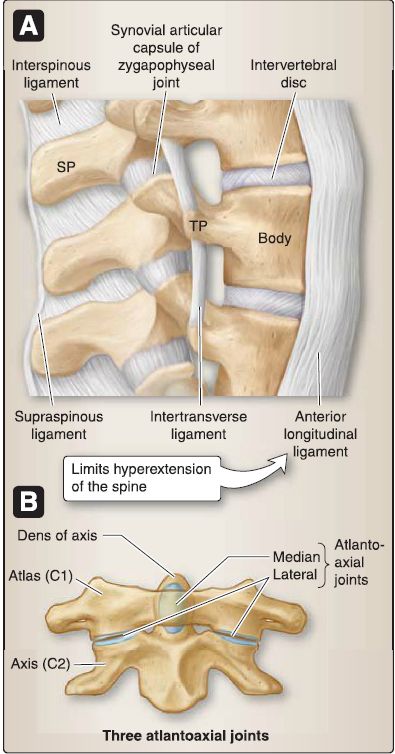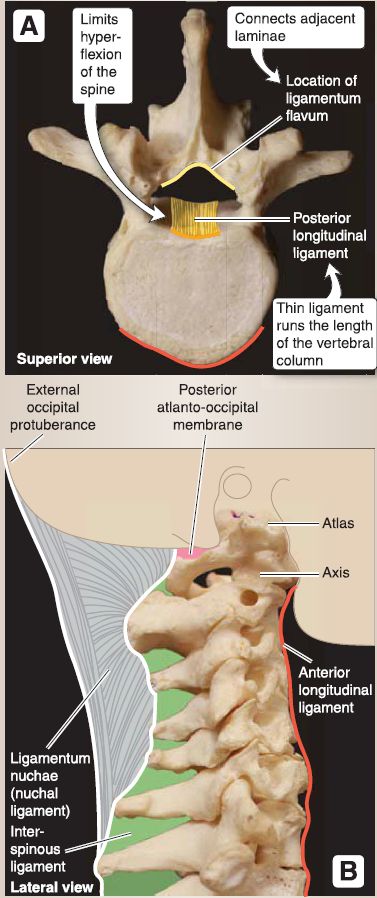


 النبات
النبات
 الحيوان
الحيوان
 الأحياء المجهرية
الأحياء المجهرية
 علم الأمراض
علم الأمراض
 التقانة الإحيائية
التقانة الإحيائية
 التقنية الحيوية المكروبية
التقنية الحيوية المكروبية
 التقنية الحياتية النانوية
التقنية الحياتية النانوية
 علم الأجنة
علم الأجنة
 الأحياء الجزيئي
الأحياء الجزيئي
 علم وظائف الأعضاء
علم وظائف الأعضاء
 الغدد
الغدد
 المضادات الحيوية
المضادات الحيوية|
Read More
Date: 1-8-2021
Date: 5-11-2015
Date: 5-11-2015
|
Joints and Ligaments
Joints of the vertebral column include both synovial and symphysis type articulations (Fig. 1). Anteriorly, adjacent vertebral bodies are joined by interposed intervertebral discs (symphysis type), allowing for weight bearing and contributing to the strength of the spine.

Figure 1 :Zygapophyseal (facet) joints.A, Lumbar region. B, Atlantoaxial joints. SP = spinous process, TP = transverseprocess.
A. Joints
Posteriorly, zygapophyseal joints (synovial type) occur between the articular processes bilaterally, and orientation of the articular facets dictates regional type and range of motion. Finally, craniovertebral joints join the base of the skull and cervical spine. These joints are further supported through a series of ligaments.
1. Symphysis joints: Anteriorly, adjacent vertebral bodies are joined by intervertebral discs. lntervertebral discs are present at all presacral levels except between the occiput, atlas (C1), and axis (C2). These joints are formed between the annulus fibrosus of the disc and a thin layer of hyaline cartilage on the articular surface of the vertebral body.
2. Synovial joints: Synovial plane joints are supported by an articular capsule and allow for gliding in different planes, depending on the spinal region. For example, in the cervical spine, these joints are oriented between the horizontal (transverse) and frontal (coronal) planes, allowing for a wide range of motion. Conversely, lumbar facet joints are oriented in the sagittal plane, allowing mainly spinal flexion and extension with minimal side-bending and rotation.
a. Zygapophyseal joints (facet joints): Posteriorly, zygapophyseal joints occur between superior and inferior articular processes on either side of the vertebral arch of adjacent vertebrae.
b. Craniovertebral joints: These include the atlanto-occipital joint between the occipital condyles and C1 (atlas) and the atlantoaxial joint between C1 and C2 (axis). The atlanto-occipital joint permits head nodding (e.g., nodding "yes"), whereas the atlantoaxial joint allows for head rotation (e.g., "no" movement). Rotation at the atlantoaxial joint occurs around the axis of the dens of C2.
B. Ligaments
The vertebral column is supported by a series of ligaments that limit excessive spinal motion (Fig. 2). The anterior longitudinal ligament spans from the occipital tubercle to the sacrum over the anterior and lateral surfaces of vertebral bodies and discs. This ligament is wide and strong and prevents hyperextension of the spine. The posterior longitudinal ligament runs along the posterior surface of the vertebral bodies and discs from the axis to the sacrum and coccyx. This ligament is thin and provides little resistance to disc herniation, especially in the lumbar region. It prevents hyperextension.

Figure 2: Vertebral ligaments. A, Lumbar spine. B, Cervical spine.
1. Posterior ligaments: The supraspinous ligament runs over the tips of the spinous processes, connecting adjacent spines. In the cervical region, the supraspinous ligament is replaced by the nuchal ligament, which has higher elastic connective tissue content and forms a strong midline band of tissue that is easily palpated.
2. Segmental ligaments: These span between various vertebral structures and include the interspinous and intertransverse ligaments, between the spinous and transverse processes, respectively. The ligamentum flavum connects adjacent laminae, forming the posterior wall of the vertebral canal.
3. Ligaments of the craniovertebral joints: These include anterior and posterior atlanto-occipital and tectorial membranes, alar ligaments, and the cruciate ligament (transverse ligament of atlas and longitudinal bands}. The transverse ligament of the atlas is crucial in maintaining the atlantoaxial joint position and in keeping the dens of C2 from being driven posteriorly into the spinal cord or superiorly into the brainstem .
4. Inferior ligaments: A series of strong ligaments anchor the spine to the pelvis, including the iliolumbar and sacroiliac ligaments.



|
|
|
|
تفوقت في الاختبار على الجميع.. فاكهة "خارقة" في عالم التغذية
|
|
|
|
|
|
|
أمين عام أوبك: النفط الخام والغاز الطبيعي "هبة من الله"
|
|
|
|
|
|
|
قسم شؤون المعارف ينظم دورة عن آليات عمل الفهارس الفنية للموسوعات والكتب لملاكاته
|
|
|